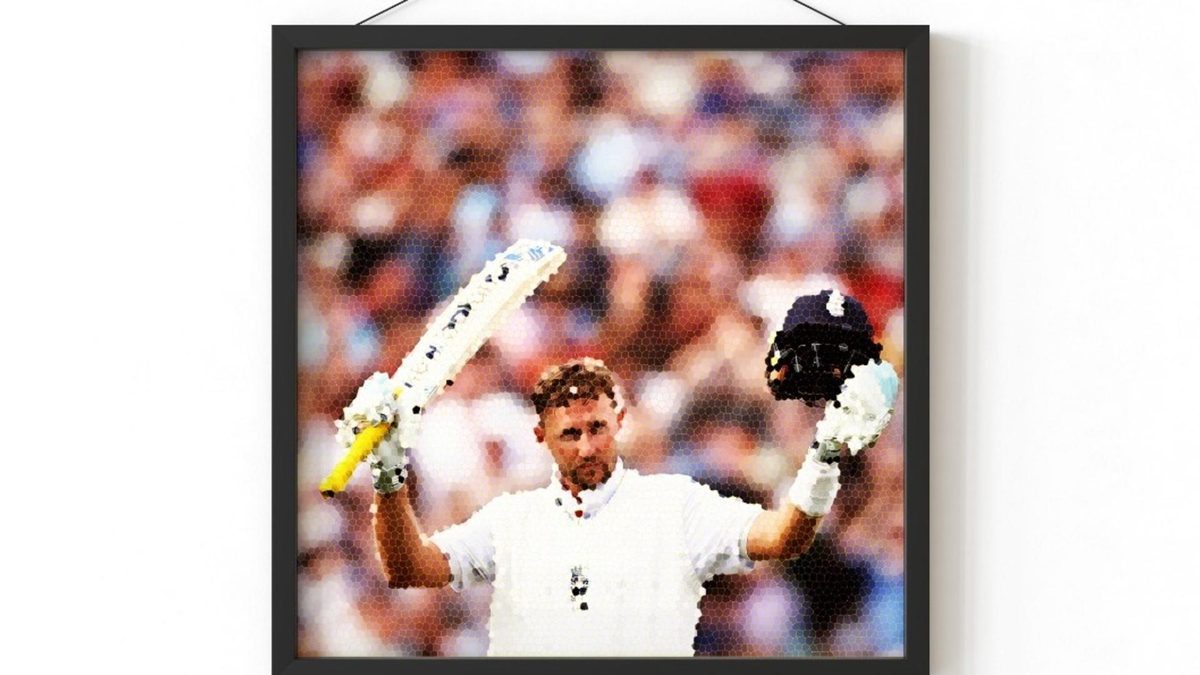
Following a three-ton series against India which nudged him into second place in Test cricket’s all-time list of run-scorers, Wisden Cricket Monthly editor-in-chief Phil Walker considers the art behind Joe Root’s numbers.
I first interviewed Joe Root in 2015, about a month after his celestial 130 at Trent Bridge, the innings that reclaimed the Ashes. Still a few months shy of his 25th birthday, he’d already accrued more runs before the age of 25 than any other player in history.
I watched him that day moving about the indoor school at Headingley, eluding the snappers and media guys and slipping past Stokes and Wood, who were larking it up elsewhere, this ethereal barely-there presence. I wrote something along the lines that you only notice him in order to wonder how the most noteworthy player of the English century could be so unnoticeable. A decade on, we’re still wondering.
These days, we record these daily podcasts to push out across the Test series, and this is how they go: first we’ll labour over some shot or other, dwelling on a pretender or two, invariably inflating a scrappy half-century into a “statement knock” or useful spell into “one for the ages”. It’s all good stuff. Yet when we get to the ‘Joe bit’, the words run dry.
What more is there to say? “Oh, and Joe will resume tomorrow unbeaten on 147, hoping to build on his latest Test hundred”? We’ve basically reached the point where language is redundant (not ideal); better to look upwards, across that vista of skyscrapers stretching out beyond what the eye is able to capture and the brain compute.
There was something else I learned at Leeds that day. Joe Root likes fine art. He got an ‘A’ at GCSE in the subject and would have taken it at A-Level if all that world domination stuff hadn’t got in the way. Watercolours, pencil drawings, and acrylics, he told me. That was his bag.
I sometimes think about this when he bats and wonder if, you know, there’s some kind of correlation there – a sensibility, perhaps, to the form and texture of things; a feel for the essential truths of metaphor and imagery; an aesthetic impulse, if you will, suffusing the shapes he makes at the crease. And then I think he might just like pretty pictures. (No idea if this stacks up by the way, but it could be fun to find out. Maybe Paul Collingwood’s snooker room’s a hive of post-impressionism? Who’s to say there aren’t a clutch of Caravaggios hanging in Graeme Smith’s utility room? And, to be fair to Mark Waugh, he’s always struck me as more of a dogs-in-waistcoats kind of guy.)
Root’s favourite, anyway, is an American portraitist called Chuck Close. “He’s a bit weird and wacky but it’s an interesting style,” he told me. Close’s signature work involved daubing hundreds of separate abstract markings onto vast canvases, and only as the viewer stepped away from the image would these markings coalesce to form a realistic whole.
Root’s favourite, anyway, is an American portraitist called Chuck Close. “He’s a bit weird and wacky but it’s an interesting style,” he told me. Close’s signature work involved daubing hundreds of separate abstract markings onto vast canvases, and only as the viewer stepped away from the image would these markings coalesce to form a realistic whole.
Root has been painting his own masterpiece for the best part of a decade and a half now, meticulously arranging his own small splotchy marks, playing with the form at times, all in dedication to building a body of work both prolific and beautiful. He’s gone through the styles to arrive at this point, his late period, spare and stripped to the essentials, techniques mastered and risks eliminated.
Ten years ago, for that piece, I spoke to his mentor about his game. “Technically, when I first saw Joe play, I thought he may have been a bit cautious, but as he’s grown he’s become more expansive. His mindset has changed. Quickly he grew into recognising the importance of putting them under pressure.”
No one knew his game more intimately than Graham Thorpe.
Since turning 30 at the end of 2020, Root has made 22 Test hundreds in 61 matches. Never underestimate how ridiculous those numbers are. His 39th and most recent came earlier this month at The Oval, for which no one was surprised, not least his opponents, against whom he now has 13 [THIRTEEN] centuries.
But the inevitability of it happening couldn’t dilute its symbolism. For when Root went to three figures, edging past Kumar Sangakkara on the list of all-time century-makers, he dug into the pocket of his trousers, pulled out his Thorpe headband and wrapped it round his forehead.
Quietly, he gave a quick gesture, pointing up to the skies. It was a tender, private moment. But it also felt, to me at least, that it was available for all of us, opening up a brief shared moment to memorialise a kind and soulful figure who lives on in the vast shared heart of English cricket. The applause only softened once Joe took guard and went again.
Only 2,378 to go. Not that anyone’s counting.
This article appears in issue 90 of Wisden Cricket Monthly, available to pre-order now.








